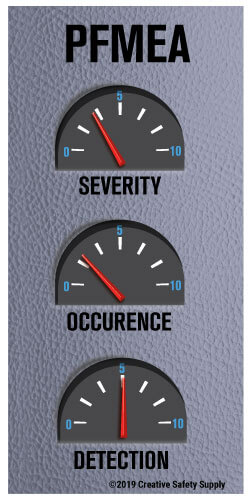
Using a Process Failure Mode and Effects Analysis, also referred to as Process FMEA, is one of the most common types of FMEA and is focused on assessing and improving specific  processes. Like an FMEA, the results will prioritize higher risks with the goal to work on improving the process. Completing a PFMEA gives managers a structured approach to analyze potential failures in the manufacturing process, and what the impact of these failures could be.
processes. Like an FMEA, the results will prioritize higher risks with the goal to work on improving the process. Completing a PFMEA gives managers a structured approach to analyze potential failures in the manufacturing process, and what the impact of these failures could be.
It is important to note these analyses should be completed by a team to identify which processes could really benefit from an FMEA, and to include workers who have extensive experience with the process at hand. A PFMEA would not be successful if only one individual works on it. Completing a PFMEA would also be greatly improved if the team performs a Gemba walk to identify processes that would truly benefit from a PFMEA. Often times businesses conduct too many analyses which can consume resources without returns.
After the process has been selected to analyze, the team should begin by a process map for the FMEA process. Like FMEA, the same three categories exist when completing a PFMEA: severity, occurrence, and detection. Each category is assigned a score between one and ten with one meaning low risk or low probability of occurring, and failure will most likely be detected in the testing phase. On the other hand, a score of ten represents an extremely high risk, failure will most likely occur, and any faults of failures will not be detected.
The resulting scores will be multiplied to determine the Risk Priority Number (RPN). This number once sorted from highest to lowest) will give you a list with the processes that need he most attention at the top. Managers will then be able to address ways to solve the potential failures through improved process controls or increased detection controls. Managers can use the PFMEA framework to analyze any processes that takes place within the scope of manufacturing and improve them accordingly.
Similar Glossary Terms
- FMEA (Failure Modes and Effects Analysis)
- DFMEA (Process Failure Modes and Effects Analysis)
- Risk Priority Number (RPN)
- FRACAS (Failure Reporting, Analysis and Corrective Action System)
- Job Safety Analysis (JSA)
- APQP (Advanced Product Quality Planning)
- RCM (Reliability Centered Maintenance)
- Workflow Process
- Fault Tree Analysis (FTA)

